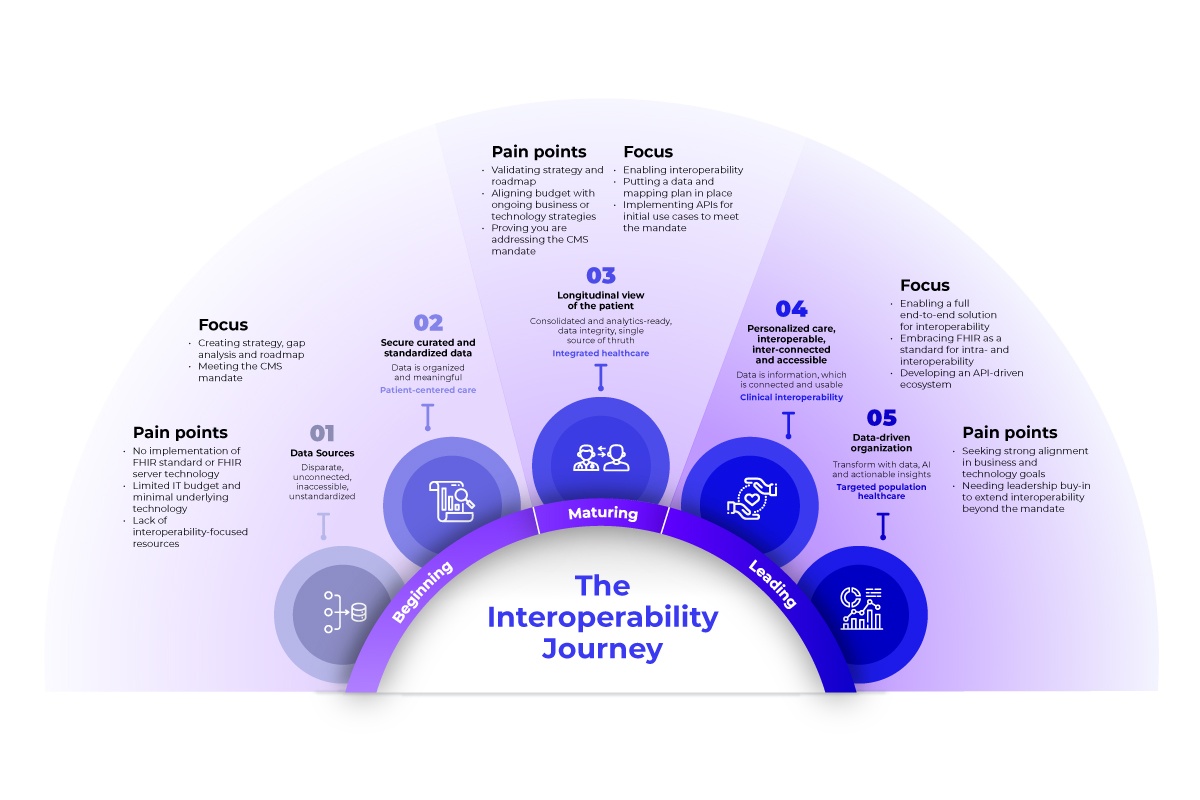
The journey of navigating healthcare interoperability is a critical one, and an incredibly complex endeavor. Healthcare organizations must tackle big tasks like accessing exchange networks, mapping messages across systems, and integrating with multiple data sources while also operating within tight compliance rules. It can be especially daunting for executives tasked with ensuring successful implementation. If this describes you or someone on your team, don’t worry—there are ways to ensure success as you undertake the process of achieving healthcare interoperability.
In this article we explain what it means to embark on an interoperability journey and how best to implement it throughout an enterprise organization.
Stage 1: Strategy and Roadmap
Beginning the healthcare interoperability journey involves addressing key pain points, such as:
- A lack of common standards and communication protocols between existing health systems like Electronic Medical Record (EMR), Laboratory Information Systems (LIS), etc.
- Limited IT budgets and minimal underlying infrastructure
- A shortage of interoperability-focused resources
To tackle these challenges, the first step is to create a well-defined strategy, followed by a comprehensive gap analysis and a dynamic roadmap aimed at ensuring regulatory compliance and achieving seamless integration of healthcare data. A crucial aspect of this journey is addressing the CMS (Centers for Medicare and Medicaid Services) mandate that requires healthcare organizations to adopt and implement interoperability standards.
At this stage of the interoperability journey, organizations move from having disconnected data systems to making data organized and manageable. Applications of interoperability at this stage include patient-centered care.
The importance of securing curated and standardized health data
Securing curated and standardized data is crucial in ensuring that information is both organized and meaningful, particularly in the context of patient-centered care. By utilizing a data curation process, healthcare providers can effectively gather, annotate, and maintain relevant datasets that accurately represent patients’ medical histories, conditions, and preferences. This process often involves removing inconsistencies or inaccuracies, as well as integrating data from various sources into one unified platform. Standardizing this data in accordance with industry regulations or established protocols, such as the International Classification of Diseases (ICD) or Systematized Nomenclature of Medicine – Clinical Terms (SNOMED CT), enables seamless communication and the exchange of information.
Furthermore, the implementation of advanced security measures, including encryption and robust access controls, helps protect sensitive patient information from unauthorized access or potential breaches, adhering to privacy standards like the Health Insurance Portability and Accountability Act (HIPAA). Altogether, the rigorous curation, standardization, and security of data serve as foundational elements in the journey to interoperability.
Stage 2: Validating Strategy
The journey towards interoperability maturity is a complex and ongoing process, requiring healthcare organizations to regularly validate their strategies and roadmaps, align budgets with evolving business needs and technological advancements, and comply with CMS mandates. Achieving interoperability maturity involves focusing on core aspects such as:
- Enabling seamless communication and coordination between disparate systems
- Instituting a robust data management plan with accurate data mapping
- Leveraging cutting-edge API technologies to address diverse use cases efficiently
Organizations must stay ahead of the curve by continuously assessing and refining their interoperability efforts with industry best practices and regulatory requirements as benchmarks. This iterative approach ensures that organizations can consistently drive improvements in care delivery, patient satisfaction, and long-term healthcare outcomes.
By this stage in the interoperability journey, companies graduate from simply having organized data systems to making them data analytics ready. This enables organizations to track patients over a longer period and participate in integrated healthcare.

Stage 3: Developing and end-to-end ecosystem for healthcare interoperability
The last stage in the healthcare interoperability journey is about addressing the alignment between business and technology objectives. A fundamental aspect of this stage is obtaining leadership buy-in, thereby empowering organizations to extend their interoperability initiatives beyond what is mandated by regulatory and industry requirements.
By focusing on enabling a comprehensive end-to-end solution for interoperability, organizations can leverage the potential of emerging standards, such FHIR, to facilitate seamless intra- and cross-organizational data exchange. Additionally, investing in the development of an Application Programming Interface (API)-driven ecosystem allows organizations to foster a highly connected, flexible, and scalable technology infrastructure that promotes innovative and improved patient-centric care services.
In the final stage of the healthcare interoperability journey, organizations are in the position to develop data driven applications (e.g predictive analytics, advanced reporting, population health management, etc.) using the latest technologies like AI to improve patient outcomes, enhance operational efficiency & increase profitability.
Get Started on your Healthcare Interoperability Journey with Blanc Labs
Interoperability can seem daunting, especially when trying to make sense of the entire journey. However, if approached methodically and incrementally with a well-thought-out strategy and roadmap, the end result can be a more secure, efficient, and user-centric system. Starting with developing the vision for an ecosystem that works for both you and your customers should give you confidence for making investments in interoperability technologies.
To understand how the interoperability journey will apply to your organization, simply speak to an expert from Blanc Labs today.